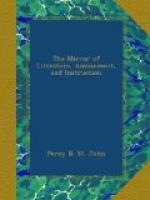CLARENDON HOUSE, PICCADILLY.
[Illustration: Clarendon house, Piccadilly.]
The virtuous and uncompromising chancellor, the Earl of Clarendon, had a splendid mansion facing the upper end of St. James’s-street, on the site of the present Grafton-street. Of this princely pile, the above is an accurate engraving. It was built by Clarendon with the stone intended for the rebuilding of St. Paul’s. “He purchased the materials,” says Pennant, “but a nation soured with an unsuccessful war, with fire, and with pestilence, imputed everything as a crime to this great and envied character; his enemies called it Dunkirk House, calumniating him with having built it with the money arising from the sale of that town, which had just before been given up to the French, for a large sum, by his Master.”
It is true that Clarendon built this mansion in a season of discontent; but so sensible was he of his vanity and imprudence in building so large a house, and of the envy it drew upon him, that he afterwards apologized for the act; which he declares, so far exceeded the proposed expense, as to add greatly to the embarrassment of his affairs.
This mansion cost L50,000. and 300 men were employed in the building. It was purchased from his lordship by George Monk, Duke of Albemarle, and afterwards by another nobleman, inferior indeed in abilities, but not inferior in virtues. In 1670, James, Duke of Ormond, resided at Clarendon House; and on his way thither, he was one day dragged out of his coach by the infamous Blood and his associates, who intended to hang his Grace at Tyburn, in revenge for justice done, under his administration in Ireland, on some of their companions. “This refinement in revenge,” says Pennant, “saved the duke’s life; he had leisure to disengage himself from the villain on horseback, to whom he was tied; by which time he was discovered by his servants, and rescued from death.”
The original of our Engraving was copied from a rare print, which, in the year 1790, was in the collection of Thomas Allen, Esq. Appended to the former is a section, showing the relative situation of Clarendon House, which was taken from a map of London (supposed to be unique) in an illustrated Clarendon’s History, in the possession of John Charles Crowle, Esq. By the section, the entrance-gate to the court-yard of the house appears to have been in Piccadilly, in a direct line with St. James’s Street, and the grounds to have extended to Bruton Street at the back, where there was likewise a communication. The site of the front gate is now, therefore, the commencement of Albemarle Street, named after one of the distinguished occupants of Clarendon House.




